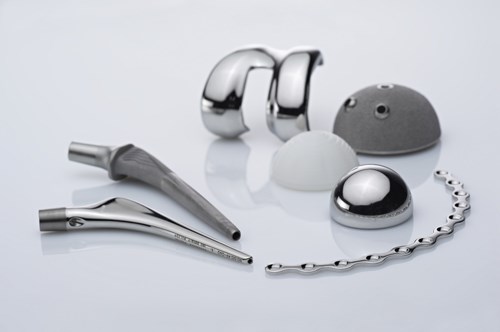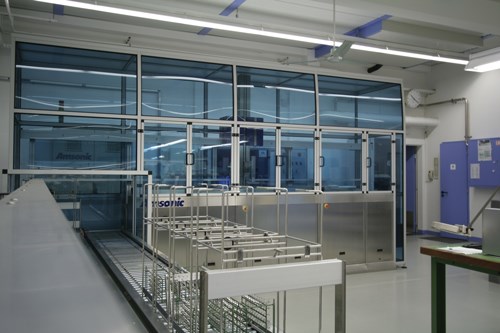Using Sound Wave Power Effectively
Whether in medical technology, the automotive industry, hydraulics or other fields, ultrasonic cleaning can be the trump card for removing impurities from components.
Ultrasonic cleaning is a process with many applications. The strengths of this cleaning method lie in the ability to precisely adapt the sound waves to the object to be cleaned and the specific cleaning task involved. Ultrasonic cleaning also requires short handling times and less use of chemicals.
Ultrasound has been used as a cleaning process for almost 100 years. It has spread into a wider range of manufacturing applications than almost any other cleaning technology because it enables efficient, gentle and rapid removal of particulate contaminants such as fine grains, chips and dust as well as the surface films left behind by oils, emulsions and similar processing agents. It can even handle parts with complex geometries and inaccessible areas such as blind holes, crannies and undercuts. At the same time, the sound wave power allows reduced use of cleaning chemicals.
Reduced Cleaning Time
The sound waves for ultrasonic cleaning are produced by a generator that converts the normal supply frequency of 50-60 Hz into high-frequency oscillations. The electromagnetic oscillations are then converted by an audio transducer into mechanical vibrations at the same frequency, and these are transmitted into a fluid bath. This process produces a physical effect known as cavitation: The high intensity of the sound wave pressure during the expansion phase of the ultrasound wave causes ruptures in the fluid, forming millions of microscopic bubbles. In the compression phase that follows, these cavitation bubbles become unstable and implode. A high hydraulic pressure with significant energy density is generated, causing microstreaming in the fluid. When these microstreams come in contact with a surface, they strip away any contaminants on it and flush them away. This aggressive cleaning action can cut cleaning time by as much as 90 percent.
The oscillator system is available with rod, immersible and plate-form transducers, as well as ultrasonic units that work with individual elements.
Correct Chemical Agent
The basic chemical principle, “Like dissolves like,” should be applied when determining the best cleaning medium for a given application. In other words, when working with a mineral-oil-based (non-polar) cooling lubricant, such as machining oil, grease or wax, a solvent is generally the right choice. Once the oil is removed, chips and particles lose their grip on the surface and are cleaned away ultrasonically.
For water-based (polar) contaminants such as coolant and lubricant emulsions, polishing pastes, additives, salts, wear particles and other solids, water-based cleaning agents are generally used. They are available in pH-neutral, alkaline and acid form. To ensure that the cleaning agent will not attack the workpiece, cleaning trials should be performed with the manufacturers of the cleaning medium.
Determining the Optimal Frequency
Frequency is another key criterion for success when using ultrasonic cleaning. In general, the lower the frequency, the larger the cavitation bubbles and the greater the energy released from the bubbles. A low frequency, therefore, produces high cleaning forces on the surface of the component. But conversely, the depth effect, which is required to penetrate interfaces such as pores, drill-holes and structures, is low. The solution is to use variable-frequency ultrasound for workpieces with a complex geometry and/or stringent cleanliness requirements. Until recently, separate baths were required for variable-frequency cleaning. In the last few years, multi-frequency or mixed-frequency ultrasound systems have enabled the fluid to be irradiated in a single bath at several frequencies, such as 25 kHz and 40 kHz. The mixture of larger and smaller cavitation bubbles provides optimal cleaning power both at the surface and in the interfaces, at the same time permitting design of ultrasound systems with a smaller footprint.
Ensuring Adequate Power
The cleaning effect is also influenced by the number and positioning of transducers in the cleaning bath. Allowing 8 to 10 watts of ultrasound power per liter of volume in the bath usually ensures adequate cleaning effect. Thus, a 100-liter cleaning bath would require an output power of 800 to 1,000 watts. If stubborn contaminants need to be removed, or if a very high degree of cleanliness is required, the ultrasound power may be even higher. Cleaning trials with original contaminated components provide a reliable determination of the required ultrasound power.
The sound waves spread out lengthwise (longitudinally) through the fluid bath from the sound-emitting surfaces, creating dead and active sound zones. The precise arrangement of the vibration transducer elements, therefore, has a big influence on the effectiveness of the cleaning. If vibration transducers are attached only to the floor of the work chamber or cleaning basin, the sound will be directed vertically upward toward the surface of the bath, and will be reflected back from the surface to the floor. This limited flow of the sound waves can have a negative effect on the cleaning of parts that contain cavities and blind holes. If air bubbles form in these cavities, the air acts as a barrier to the sound and no cleaning takes place. It is therefore important to ensure that all cavities are filled with cleaning fluid, which can be achieved by oscillating or rotating the parts in the bath. Many ultrasound generators are also equipped with a “sweep” function, for frequency modulation, to distribute the ultrasound vibrations evenly in the cleaning fluid. Also, an increasing number of ultrasound systems for cleaning components with complex geometries are now equipped for multi-sided irradiation, from both the floor and the side walls.
Good Access
Apart from air, other barriers can also inhibit the unrestricted access of the sound waves to the item to be cleaned and prevent an optimal result. These barriers include cleaning containers that are totally enclosed or made of perforated sheet. The ideal workpiece holders and parts baskets are made of round wire, allowing good access on all sides, both for the ultrasound and the cleaning medium. When loading the workpiece holder or parts basket, the surfaces to be irradiated should not be greater than the sound-emitting areas, and the mass of the part or parts should not exceed 50 percent of the bath’s volume. Loading parts too compactly (such as many items piled close on top of each other) can prevent the ultrasound from reaching all the surfaces that are to be cleaned, resulting in inadequate cleaning quality and long treatment times.
The correct use of ultrasound, combined with a cleaning agent suited to the contaminants, can shorten the cleaning time by as much as 90 percent, while reducing the consumption of cleaning chemicals.
Related Content
A ‘Clean’ Agenda Offers Unique Presentations in Chicago
The 2024 Parts Cleaning Conference, co-located with the International Manufacturing Technology Show, includes presentations by several speakers who are new to the conference and topics that have not been covered in past editions of this event.
Read MoreMeeting Stringent Cleaning Goals With Modular Ultrasonic System
A knee implant manufacturer implements an advanced cleaning system that meets its tight cleaning requirements, including documenting, validating and tracing the entire cleaning process.
Read MoreSita’s CleanoSpector Measures Part Cleanliness
PMTS 2023: Handheld measuring device checks for cleanliness of parts to assure product quality as well as prior to follow-up processes.
Read More2 Tales About Cleaning with CO2
These two manufacturers discovered different ways to use automated snow-jet cleaning technology, which offers a dry, fast and efficient cleaning process for small parts.
Read MoreRead Next
Meeting Medical Manufacturing’s Tough Demands
When properly applied, ultrasonic cleaning technology is well suited to play a major role in helping medical manufacturers meet their increasing need for critical cleaning.
Read MoreThe Value of Swiss-Types Milling Rectangular Medical Parts
High-speed spindle technology was key to effective milling of small cardiac monitoring components complete on a CNC sliding-headstock machine platform instead of running them across two mills.
Read MorePredicting the ROI of Robotic Automation
Various methodologies paired with online tools can help small to mid-sized manufacturers determine how to predict and calculate the potential economic benefits of robotic equipment for their specific needs.
Read More

























